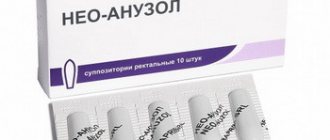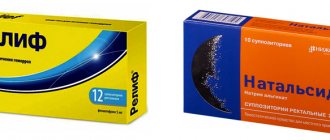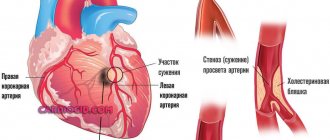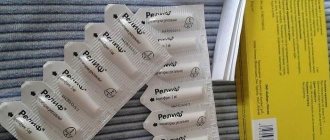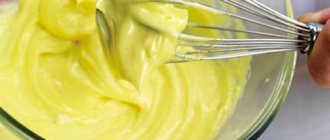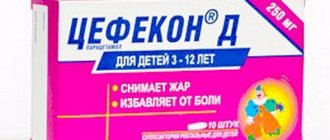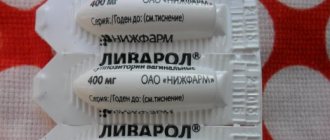Hemorrhoids develop in 80% of women in the postpartum period. The causes of its appearance are associated with excessive load on the veins in the pelvis during pregnancy and strong pushing during labor. Properly selected suppositories for hemorrhoids after childbirth and during lactation can ease the course of the disease and speed up recovery.
Properly selected suppositories for hemorrhoids after childbirth and during lactation can ease the course of the disease and speed up recovery.
Healing power
Suppositories in the treatment of postpartum hemorrhoids have a number of advantages - impact directly on problem areas, minimal side effects, ease of use. Suppositories for the treatment of hemorrhoids during lactation are made from natural oils and fats with the addition of plant extracts.
Positive results from their use:
- Stop bleeding.
- Elimination of pain.
- Removing venous stagnation.
- Tissue regeneration.
- Prevention of relapse.
Can external hemorrhoids go away on their own?
If the provoking factors are eliminated at an early stage, the clinical manifestations quickly disappear and hemorrhoids go away. If this is not done, it will progress and enter a severe stage.
Eliminate provoking factors for the development of the disease:
- Sedentary lifestyle. Mostly sedentary work, long periods of time standing on your feet.
- Lifting and moving loads of significant weight.
- Hard physical labor.
- Playing big sports.
- Violations of diet and eating habits, leading to the development of constipation.
Safe candles
This category includes drugs that contain only substances that are safe for mother and child.
Natalsid
Natalsid is a medicine that has proven itself in the treatment of acute hemorrhoids with blood after childbirth.
Natalsid is a medicine that has proven itself in the treatment of acute hemorrhoids with blood after childbirth.
Suppositories help stop bleeding from the veins of the rectum, relieve inflammation and heal microcracks. This complex effect is achieved due to the presence of sodium alginate and alginic acid in the composition.
The use of Natalsid suppositories helps normalize stools and prevent constipation.
A positive therapeutic effect develops after 4-5 days, and within 14 days the inflammatory process completely resolves.
Sea buckthorn candles
Sea buckthorn suppositories are a product of plant origin, suitable for the treatment of hemorrhoids during lactation, because active components do not penetrate into the blood. Sea buckthorn suppositories are effective in the initial stages of the disease and anal fissures.
Their regular use allows you to heal the irritated mucous membrane of the rectum, eliminate anal itching and pain. The drug has a contraindication for use - allergic intolerance.
Hemo-pro
Homeopathic suppositories Gemo-pro are made from natural ingredients - propolis, sea buckthorn extract, medicinal mud, herbal extracts (comfrey, rue, St. John's wort). Suppositories are safe for mother and child, but if they are prone to allergies, they are used with caution.
Gemo-pro suppositories have a complex effect:
- Suppress the activity of pathogenic bacteria, preventing the development of secondary infection.
- Accelerate the regeneration of damaged tissues.
- Reduce pain and swelling.
- Strengthens blood vessels and improves blood flow.
Posterisan
Posterizan suppositories belong to the category of anti-inflammatory and immunostimulating. The drug contains inactivated E. coli cells, due to which it is able to increase local immunity and accelerate recovery.
Posterisan promotes rapid healing of microcracks and hemorrhoids.
The medicine promotes rapid healing of microcracks and hemorrhoids, stopping bleeding. The use of Posterizan minimizes the risk of re-development of hemorrhoids.
Neo-anuzole
Neo-anuzole suppositories have a pronounced antihemorrhoidal effect due to their complex composition - zinc oxide, bismuth nitrate, tannin, iodine.
The drug does not accumulate in the body and is approved for use in nursing mothers.
Neo-anuzole suppositories are prescribed for postpartum hemorrhoids with prolapsed hemorrhoids, severe pain and discomfort. The drug has astringent properties and helps relieve acute inflammation.
Candles with calendula
A remedy from the category of homeopathy. The active ingredient is calendula tincture in a volume of 0.05 g in each suppository. Calendula suppositories are safe and can be used to treat hemorrhoids while breastfeeding.
The medicine is prescribed to relieve inflammation of hemorrhoids during an exacerbation. Calendula tincture in the composition has a bactericidal effect, relieves swelling, redness and blood flow from swollen veins.
Calendula suppositories are safe and can be used to treat hemorrhoids while breastfeeding.
What external hemorrhoids look like - photo
Depending on the stage, nodes can be of different sizes.
what does external hemorrhoids look like
Stages of external hemorrhoids - symptoms
The first stage is a mild external manifestation in the anal area. Discomfort appears during defecation. itching, burning, and a feeling of fullness appear.
The second stage - swelling increases, inflammation appears, and pain intensifies. Pronounced nodes appear. The nodes sometimes hurt with a pulsating sensation.
Third stage - The nodes grow, and after reduction they fall out again. Severe pain appears. Body temperature may rise.
Stage four - the nodes cannot be adjusted independently; swelling and redness appear in the area of external inflammation. Thrombosis of the node may occur, the tissues become burgundy and bluish.
Less safe candles
Medicines from this group are prescribed for hemorrhoids after childbirth, but only if safe drugs do not provide relief. The treatment process should be supervised by a doctor to avoid negative effects on the child.
Gepatrombin G
Gepatrombin G - suppositories with a combined effect - anti-inflammatory, anticoagulant, antiallergic. Active substances: heparin, prednisolone, lauromacrogol.
The drug is used to treat moderate and moderately severe forms of hemorrhoids with multiple hemorrhoids, burning and pain, and anal fissures.
After a course of use of suppositories, swelling decreases, the mucous membrane is restored, and blood supply in the pelvis is improved.
Procto-Glyvenol
Suppositories with extended therapeutic effect. The composition contains tribenoside (venotonic) and lidocaine (analgesic).
Procto-Glivenol is used to eliminate the manifestations of internal and external hemorrhoids after childbirth.
When used during breastfeeding, the possible risk to the baby should be taken into account. Procto-Glivenol is used to eliminate the manifestations of internal and external hemorrhoids after childbirth. The medication increases venous tone, reduces vascular fragility, and has an anti-inflammatory effect. Lidocaine reduces pain. Procto-Glyvenol acts quickly, improvement in well-being occurs after 1-2 suppositories.
Anestezol
The drug for rectal use contains menthol, benzocaine, zinc oxide and bismuth subgallate. The active components enter the systemic bloodstream, so before use during the lactation period it is necessary to consult a specialist.
Anestezol is prescribed for any form of postpartum hemorrhoids.
Suppositories help with weeping in the anus, spasms, and hemorrhages in the rectum. The medicine has a wound-healing and mild disinfecting effect.
Removal of external hemorrhoids
Excessive blood loss leads to anemia. The only option to avoid serious complications is to schedule a timely operation to remove hemorrhoids.
Milligan-Morgan operation
During the operation, the hemorrhoidal node is excised along with the mucous membrane. This type of hemorrhoidectomy is most acceptable for both the doctor and the patient. This is the only surgical method that is performed for external hemorrhoids and can be performed in the following two ways:
Open . After the hemorrhoids are removed, the wounds are not sutured, but remain open. Further healing occurs naturally.
Closed . After excision of the cones, the wound is sutured, which facilitates and shortens the rehabilitation period and reduces the risk of complications.
There is another method of performing surgical intervention for hemorrhoids - submucosal , when it is not the hemorrhoid itself that can be removed, but the mucous membrane located next to it. This type of operation is rarely used, as it is difficult for a doctor and can only be performed in a hospital setting, while closed surgery involves performing the procedure on an outpatient basis.
Prohibited
The pharmaceutical industry produces antihemorrhoidal suppositories that are prohibited for use after childbirth and during the lactation period.
After childbirth and during the lactation period, it is prohibited to use Relief Ultra suppositories.
These include hormone-containing suppositories - Gepazolon, Ultraproct, Relief Ultra. Even with a single use, these drugs can cause hormonal imbalance and gastrointestinal problems in a child.
Benzocaine preparations for rectal use - Hemorol, Olestezin, Nigepan, Relief Advance - are not prescribed for the treatment of hemorrhoids in nursing mothers, because the question of the effect of benzocaine on the children's body has not been fully studied.
Reasons: why hemorrhoids appear
In order for this pathology to appear, there must be a certain predisposition , which consists in the weakness of the venous walls. The phenomenon is very common - according to rough estimates, more than half of the world's population suffers from external hemorrhoids.
The main cause of external hemorrhoids is a violation of the outflow of venous blood from the veins of the external hemorrhoidal plexus through the cochlear arteries due to congenital or acquired weakness of the venous walls.
It is difficult for statistics to give exact figures - considering this problem to be quite intimate, many people do not go to the doctor, trying to cope on their own, with the help of folk remedies or “neighborly” recommendations. In this case, the disease may temporarily subside, creating a deceptive illusion of well-being, only to return with renewed vigor when the opportunity arises.
as provocative factors for the appearance (exacerbation) of external hemorrhoids:
- Lack of physical activity (prolonged sitting or standing).
- Problems with bowel movements (constipation, prolonged straining or waiting).
- Lifting weights . Weightlifting.
- Dietary disorders (spicy foods, alcohol, insufficient consumption of dairy products, fruits and vegetables).
- Pregnancy and postpartum period.
Heredity may be a deciding factor. If close relatives suffer from hemorrhoids, there is a high probability of pathology occurring in the child. This occurs due to congenital vascular dysfunction in the lower rectum.
Under the influence of unfavorable factors the following occurs:
- increased blood flow;
- overflow of all vessels;
- expansion of the cavernous bodies;
- difficulty in venous outflow;
- stagnation.
Made from natural ingredients
Suppositories prepared at home are a good alternative to pharmaceutical drugs. They are easy to prepare, cheap and safe. The best suppositories for hemorrhoids after childbirth, made from natural ingredients, are ice, potato and honey.
Ice candles
In folk medicine, ice suppositories are used to eliminate hemorrhoidal bleeding and burning in the anus.
Thanks to the cooling effect, ice suppositories constrict blood vessels and reduce pain.
To prepare them, boiled water is poured into thick paper, folded into a cone, and frozen.
To enhance the therapeutic effect, you can add chamomile infusions to the water for ice candles.
To enhance the therapeutic effect, you can add infusions of chamomile and calendula to the water.
Potato
Potato juice has the ability to heal wounds and relieve inflammation. Potato suppositories accelerate the regeneration of the rectal mucosa, facilitate defecation, and eliminate anal fissures.
The preparation process is simple - smooth briquettes up to 3 cm long and 1-1.5 cm in diameter are cut from fresh potatoes.
After hygienic procedures, they are carefully inserted into the anus. To facilitate insertion, the candles can be lubricated with sea buckthorn oil.
External hemorrhoids bleed - what to do
If external hemorrhoids bleed after defecation, this is a normal manifestation of the disease. Bleeding is a typical clinical picture. But any pathological process can develop quickly. This is worth remembering.
Hemorrhoidal discharge is characterized by:
- At first the blood is dark in color, but then it becomes scarlet;
- after defecation, the blood stops on its own;
- There is no bleeding at rest.
Minor hemorrhoidal bleeding is not difficult to stop. Use ointments
- Trombless relieves pain, relieves swelling, and prevents the formation of blood clots.
- Proctosan accelerates healing and reduces inflammation.
- Hepatrombin N has a venosclerosing, antithrombotic effect.
- Bezornil is a complex drug with a hemostatic, countercurrent, astringent effect.
Causes of bleeding
Node thrombosis . In the absence of treatment, the inflammatory process intensifies in the thrombosed vein and infiltration develops. A node overflowing with blood may burst. A thrombosed lump, usually very painful. After it bursts, the person feels relief.
Constipation . Dense and dry feces when passing through the rectum irritate and injure the nodes, causing bleeding. Frequent constipation prevents the healing of damaged walls; blood appears at the first bowel movement. With constipation, excessive straining occurs, which increases intra-abdominal pressure. As pressure increases, the vessels expand, their walls lose their elasticity over time, become thinner and rupture.
Diarrhea . Frequent bowel movements with loose stools cause damage to the entire mucous membrane of the anal area and the walls of the cones.
Alcohol abuse . Ethanol sticks platelets together, which contributes to the development of varicose veins - the main pathogenetic factor of hemorrhoids.

